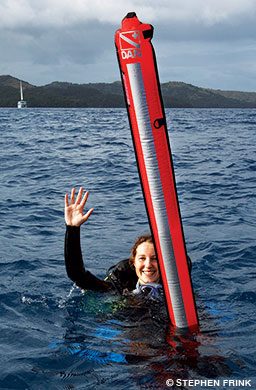Over their lifetime, divers will likely encounter a variety of dive conditions: at sea level and at altitude as well as in fresh water, salt water, calm water and currents, to name a few. Diving in currents can be exhilarating, but it can also be hazardous if you do not have the proper training or are unprepared. Current dives, often called drift dives, can be leisurely or quite challenging.
Current is the continuous movement of a fluid in a certain direction. For diving and other water activities, we consider current as water that moves through a more sedate surrounding body of water. Current movement, which can be horizontal or vertical, is sometimes slow and barely noticeable but at other times can be so strong that underpowered watercraft struggle against it. Tide ebb and flow and the current’s velocity and direction can change your position relative to either the horizontal or vertical plane of the current, which can be disorienting for inexperienced divers.
Divers can experience amazing drift dives at many popular sites worldwide, including Palau, Indonesia, Maldives, Florida, the Pacific Northwest, Cozumel, and many others. Frequently calm and relaxing, drift dives can also be quite rapid and require significant effort. All currents take special consideration and planning to dive effectively and safely. Divemasters should provide site-specific information about the current as part of their dive briefing so all divers know what to expect. Before doing drift dives, seek proper training, ideally as part of a course with a certified instructor.

Drift diving also requires physical and mental preparation. When diving currents, divers should have an elevated fitness level as well as experience and familiarity with different finning techniques. A moderate half-knot current (0.6 mph or 0.9 kph) may not seem very fast, but in the time it takes to let go of the descent line and clear your mask, you will be out of reach of the line. In strong 2-knot currents, it is challenging to keep your position steady just by kicking, and a diver could not maintain that level of effort for long.
When making a current dive other than a drift dive, start against the current, and return with it. You will increase your physical effort and breathing-gas consumption as you swim against the current, but you will use far less energy as you return to your entry and exit point and should have an adequate gas supply to finish the dive as planned. Divers should not dive in currents greater than 1 knot without proper training and experience. To roughly measure a current, toss a buoyant object into the water and time how long it takes to get to a point a known distance away. The object will travel 1.68 feet per second in a 1-knot current.
Depending on the current for a drift dive, you might have to make a negative entry, which is entering the water with little or no air in your buoyancy compensator (BC), continuing to descend upon entry, and then pairing up with your buddy and riding the current. You only need to fin when you want to approach something or remain stationary. Let the current do the hard work for you. Once you become comfortable with drift diving, you will likely use less gas than on a dive in calm water to the same depth and time because you will kick far less.

When planning dives where you will start against the current and return with the current, use the rule of thirds for your breathing gas: one-third of your gas supply for the first part of the dive, one-third for the return and one-third in reserve for an emergency. Plan on bringing additional equipment such as a surface marker buoy (SMB) and a reel, at an absolute minimum. Many divers carry a signaling mirror and a whistle in case they become separated from their buddy or boat. A reef hook may be recommended or required in some areas; ask the dive operator or local dive shop about if and where it may be needed. If you don’t know how to properly use these pieces of equipment, consult an instructor for training.
During the dive, keep yourself and your equipment streamlined and with the current’s flow. Stay close to the bottom or other objects, where the current is often not as strong as it is midwater. Sometimes you can find a bit of shelter by ducking behind a reef ledge, a wreck or some other object. Remember the basics: Monitor your air, depth and time. Stay with your group or, at a minimum, a buddy. If you and your buddy get separated from the group, make sure you stay together.
Use the ascent line during your safety stop to keep from being swept away. If you miss or become separated from the ascent line or are executing a free ascent, deploy your SMB when appropriate. The SMB will be your guideline, and the dive operator can better see where you are. Don’t panic if you get swept away during the dive or while on a safety stop or on the surface. Don’t fight against the current. Sometimes moving a few feet left, right, up or down can minimize the current’s effect.
When you’re on the surface, inflate your BC and prepare to use your signaling mirror or whistle if needed. As you exit the water, follow the procedures the dive operator outlined. Closely following those procedures when doing a live-boat pickup will help you avoid entanglements and propeller strikes.
A vertical current moving down or up, called a downwelling or upwelling, can be challenging in ways that differ from horizontal currents. Downwelling occurs when a current (usually wind-driven) meets an object — such as a submerged reef wall, an island, an atoll or other landmass — or another current. The water collides with the object, which forces the water downward.

Upwelling typically happens when wind-driven currents push water away from an area, and other water rises from below the surface to fill the vacancy. Upwelling usually occurs along coastlines but occasionally may be in the open ocean. Nutrients from deeper water come toward the surface, so the upwelling water often has much higher biological productivity. Upwelling areas are usually good for fishing.
If you are diving in an area known for upwelling or downwelling, be aware of where it usually happens. If the current pushes you into an unexpected ascent or descent, try to stop it as quickly as possible. While touching the reef is never ideal, it is acceptable in this case. Grab some solid substrate as quickly and safely as possible while trying to avoid any harmful marine life such as fire coral.
Try to protect your regulator and mask from being ripped away from you. If the current removes your regulator or mask, remain calm, retrieve your backup regulator, and continue to breathe. If you can safely recover your mask, do so, but remember that you can easily replace it.
If you are caught in a downwelling, be sure to continually equalize your ears. In an upwelling, continuously exhale, inhaling only when you need to, and then continue exhaling. If you cannot quickly stop your ascent or descent, get vertically streamlined in the water to allow the water to pass by with less drag on your body. Doing so may slow your ascent or descent and make it possible for you to maneuver to grab something solid.
Once you are under control, begin to ascend at a safe rate, and monitor your breathing-gas supply, as you will likely be breathing much faster than usual. Monitoring your gas is especially critical if you were caught in a downwelling and taken deep. If you can locate your buddy, make the ascent together, helping each other maintain control and monitoring each other’s gas supply. Make a safety stop if you can.
Diving in currents can be quite relaxing and pleasant, even in swift currents, but it has its challenges. To get the most enjoyment, perform proper predive research and dive planning. Make sure you prepare physically and mentally and have the proper gear, training and experience. Divers often say that current dives are some of their most memorable and exhilarating dives. Expand your diving repertoire by safely trying a current dive.
© Alert Diver — Q1 2021